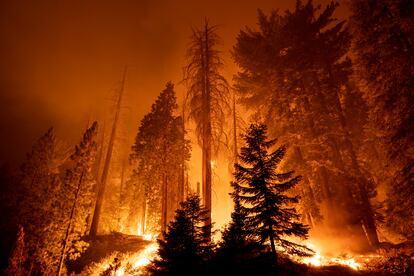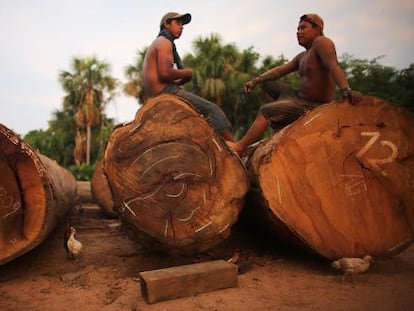Biden administration moves to protect oldest trees as climate change brings more fires, pests
The proposal would sharply limit commercial timber harvests in old-growth forests while allowing logging to continue in ‘mature forests’ that have not yet reached old-growth stage

The Biden administration moved on Tuesday to conserve groves of old-growth trees on national forests across the U.S. as climate change amplifies the threats they face from wildfires, insects and disease.
Agriculture Sec. Tom Vilsack said the agency was adopting an “ecologically-driven” approach to older forests — an arena where logging interests have historically predominated. That will include the first nationwide amendment to U.S. Forest Service management plans in the agency’s 118-year history, he said.
The proposal follows longstanding calls from environmentalists to preserve older forests that offer crucial wildlife habitat and other environmental benefits. The timber industry has fought against logging restrictions on government-owned lands.
President Joseph Biden’s administration appears to be aiming for a middle ground: It would sharply limit commercial timber harvests in old-growth forests while allowing logging to continue in “mature forests” that have not yet reached old-growth stage.
“This creates a commitment to resiliency, a commitment to restore and protect the existing old growth that we have from the threats that we see,” Vilsack said in an interview.
Old-growth forests, such as the storied giant sequoia stands of northern California, have layer upon layer of undisturbed trees and vegetation. There’s wide consensus on the importance of preserving them — both symbolically as marvels of nature, and more practically because their trunks and branches store large amounts of carbon that can be released when forests burn, adding to climate change.
Underlining the urgency of the issue are wildfires that killed thousands of giant sequoias in recent years. The towering giants are concentrated in about 70 groves scattered along the western side of the Sierra Nevada range.
Many old-growth forests fell during the second half of the 20th century during aggressive logging on national forests. Others were cut earlier as the U.S. developed.
Logging volumes dropped sharply over the past several decades, but the demise of older trees due to fire, insects and disease accelerated. More than 5,100 square miles (13,300 square kilometers) of old-growth and mature forests burned since 2000.
About 350 square miles (900 square kilometers) of older forests were logged on federal lands during that time, according to a recent government analysis.
There’s no simple formula to determine what’s old. Growth rates among different tree types vary greatly — and even within species, depending on their access to water and sunlight, and soil conditions. Groves of aspen can mature within a half-century. Douglas fir stands can take 100 years. Wildfire frequency also factors in: Ponderosa pine forests are adapted to withstand blazes as often as once a decade, compared to lodgepole pine stands that might burn every few hundred years.
Past protections for older trees have come indirectly, such as the 2001 “roadless rule” adopted under former President Bill Clinton in 2001 that blocked logging on about one quarter of all federal forests.
Chris Wood, president of Trout Unlimited and a former Forest Service policy chief who worked on the roadless rule, said the Biden administration proposal was a “step in the right direction” to protect the remaining old growth.
“This is the first time the Forest Service has said its national policy will be to protect old growth,” he said.
Representatives of the timber industry and some members of Congress have been skeptical about Biden’s ambitions to protect older forests, which the Democrat launched in 2021 on Earth Day. They’ve urged the administration to instead concentrate on lessening wildfire dangers by thinning stands of trees where decades of wildfire suppression allowed undergrowth to flourish, which can be a recipe for disaster when fires ignite.
“Let’s be real about who the groups asking for this are: They have always opposed commercial timber harvests on the national forest system,” said Bill Imbergamo with the Federal Forest Resource Coalition, a timber industry group. “Is that the correct emphasis right now when most of the old growth losses are coming from insects, fire and climate change stressors working in tandem?”
The results earlier this year from the government’s first-ever national inventory of mature and old-growth forests on federal land revealed more expanses of older trees than outside researchers had recently estimated. The Forest Service and federal Bureau of Land Management combined oversee more than 50,000 square miles (129,000 square kilometers) of old growth forests and about 125,000 square miles (324,000 square kilometers) of mature forests, according to the inventory.
Most are in Western states such as Idaho, California, Montana and Oregon. They’re also in New England, around the Great Lakes and in Southern states such as Arkansas, Kentucky and West Virginia, according to the Forest Service.
The proposal to revise management plans for 128 national forests and national grasslands is expected to be completed by early 2025. However, it’s uncertain if the change would survive if Biden loses his 2024 re-election bid.
Under former President Donald Trump, federal officials sought to open up millions of acres of West Coast forests to potential logging. Federal wildlife officials reversed the move in 2021 after determining political appointees under Trump relied on faulty science to justify drastically shrinking areas of forest that are considered crucial habitats for the imperiled northern spotted owl.
Asked about the durability of Tuesday’s proposal, Vilsack it would be “a serious mistake for the country to take a step backwards now that we’ve taken significant steps forward.”
Sign up for our weekly newsletter to get more English-language news coverage from EL PAÍS USA Edition
Tu suscripción se está usando en otro dispositivo
¿Quieres añadir otro usuario a tu suscripción?
Si continúas leyendo en este dispositivo, no se podrá leer en el otro.
FlechaTu suscripción se está usando en otro dispositivo y solo puedes acceder a EL PAÍS desde un dispositivo a la vez.
Si quieres compartir tu cuenta, cambia tu suscripción a la modalidad Premium, así podrás añadir otro usuario. Cada uno accederá con su propia cuenta de email, lo que os permitirá personalizar vuestra experiencia en EL PAÍS.
¿Tienes una suscripción de empresa? Accede aquí para contratar más cuentas.
En el caso de no saber quién está usando tu cuenta, te recomendamos cambiar tu contraseña aquí.
Si decides continuar compartiendo tu cuenta, este mensaje se mostrará en tu dispositivo y en el de la otra persona que está usando tu cuenta de forma indefinida, afectando a tu experiencia de lectura. Puedes consultar aquí los términos y condiciones de la suscripción digital.
More information
Archived In
Últimas noticias
Most viewed
- Sinaloa Cartel war is taking its toll on Los Chapitos
- Oona Chaplin: ‘I told James Cameron that I was living in a treehouse and starting a permaculture project with a friend’
- Reinhard Genzel, Nobel laureate in physics: ‘One-minute videos will never give you the truth’
- Why the price of coffee has skyrocketed: from Brazilian plantations to specialty coffee houses
- Silver prices are going crazy: This is what’s fueling the rally










































